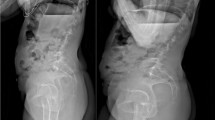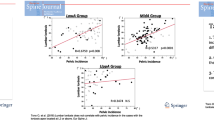Abstract
Introduction
It has become well recognised that sagittal balance of the spine is the result of an interaction between the spine and the pelvis. Knee flexion is considered to be the last compensatory mechanism in case of sagittal imbalance, but only few studies have insisted on the relationship between spino-pelvic parameters and lower extremity parameters. Correlation between the lack of lumbar lordosis and knee flexion has not yet been established.
Materials and methods
A retrospective study was carried out on 28 patients with major spinal deformities. The EOS system was used to measure spinal and pelvic parameters and the knee flexion angle; the lack of lumbar lordosis was calculated after prediction of lumbar lordosis with two different formulas. Correlation analysis between the different measured parameters was performed.
Results
Lumbar lordosis correlated with sacral slope (r = −0.71) and moderately with knee flexion angle (r = 0.42). Pelvic tilt correlated moderately with knee flexion angle (r = 0.55). Lack of lumbar lordosis correlated best with knee flexion angle (r = 0.72 and r = 0.63 using the two formulas, respectively).
Conclusion
Knee flexion as a compensatory mechanism to sagittal imbalance was well correlated to the lack of lordosis and, depending on the importance of the former parameter, the best procedure to correct sagittal imbalance could be chosen.





Similar content being viewed by others
References
Dubousset J (1998) Importance de la vertèbre pelvienne dans l’équilibre rachidien. Application à la chirurgie de la colonne vertébrale chez l’enfant et l’adolescent. In: Villeneuve P (ed) Pied équilibre et rachis. Paris, pp 141–149
Dubousset J, Charpak G, Dorion I, Skalli W, Lavaste F, Deguise J, Kalifa G, Ferey S (2005) A new 2D and 3D imaging approach to musculoskeletal physiology and pathology with low-dose radiation and the standing position: the EOS system. Bull Acad Natl Med 189:287–297 (discussion 297–300)
Itoi E (1991) Roentgenographic analysis of posture in spinal osteoporotics. Spine 16:750–756
Labelle H, Roussouly P, Berthonnaud E, Dimnet J, O’Brien M (2005) The importance of spino-pelvic balance in L5-S1 developmental spondylolisthesis: a review of pertinent radiologic measurements. Spine 30:S27–S34
Lee CS, Lee CK, Kim YT, Hong YM, Yoo JH (2001) Dynamic sagittal imbalance of the spine in degenerative flat back: significance of pelvic tilt in surgical treatment. Spine 26:2029–2035
Legaye J, Duval-Beaupere G (2005) Sagittal plane alignment of the spine and gravity: a radiological and clinical evaluation. Acta Orthop Belg 71:213–220
Legaye J, Duval-Beaupere G, Hecquet J, Marty C (1998) Pelvic incidence: a fundamental pelvic parameter for threedimensional regulation of spinal sagittal curves. Eur Spine J 7:99–103
Mangione P, Gomez D, Senegas J (1997) Study of the course of the incidence angle during growth. Eur Spine J 6:163–167
Marty C, Boisaubert B, Descamps H, Montigny JP, Hecquet J, Legaye J, Duval Beaupere G (2002) The sagittal anatomy of the sacrum among young adults, infants, and spondylolisthesis patients. Eur Spine J 11:119–125
Murata Y, Takahashi K, Yamagata M, Hanaoka E, Moriya H (2003) The knee-spine syndrome. Association between lumbar lordosis and extension of the knee. J Bone Joint Surg Br 85:95–99
Rose PS, Bridwell KH, Lenke LG, Cronen GA, Mulconrey DS, Buchowski JM, Kim YJ (2009) Role of pelvic incidence, thoracic kyphosis, and patient factors on sagittal plane correction following pedicle subtraction osteotomy. Spine 34:785–791
Roussouly P, Gollogly S, Berthonnaud E, Dimnet J (2005) Classification of the normal variation in the sagittal alignment of the human lumbar spine and pelvis in the standing position. Spine 30:346–353
Schwab F, Lafage V, Boyce R, Skalli W, Farcy JP (2006) Gravity line analysis in adult volunteers: age-related correlation with spinal parameters, pelvic parameters, and foot position. Spine 31:E959–E967
Schwab F, Lafage V, Patel A, Farcy JP (2009) Sagittal plane considerations and the pelvis in the adult patient. Spine 34:1828–1833
Vialle R, Levassor N, Rillardon L, Templier A, Skalli W, Guigui P (2005) Radiographic analysis of the sagittal alignment and balance of the spine in asymptomatic subjects. J Bone Joint Surg Am 87:A260–A267
Conflict of interest
None.
Author information
Authors and Affiliations
Corresponding author
Rights and permissions
About this article
Cite this article
Obeid, I., Hauger, O., Aunoble, S. et al. Global analysis of sagittal spinal alignment in major deformities: correlation between lack of lumbar lordosis and flexion of the knee. Eur Spine J 20 (Suppl 5), 681 (2011). https://doi.org/10.1007/s00586-011-1936-x
Received:
Accepted:
Published:
DOI: https://doi.org/10.1007/s00586-011-1936-x




